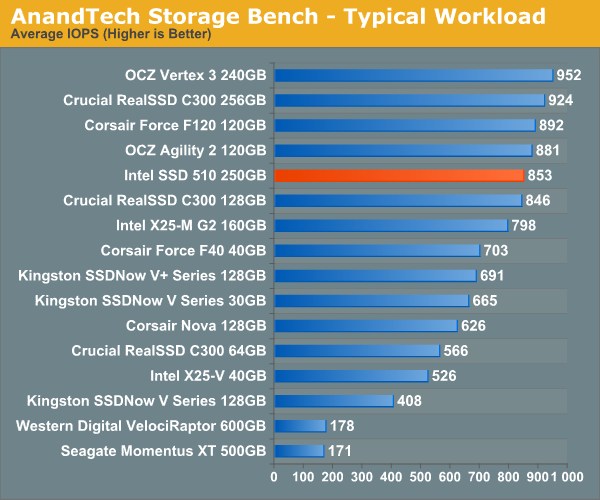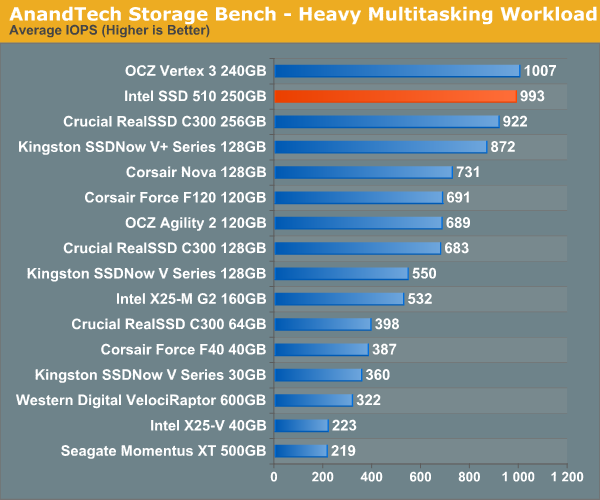The Intel SSD 510 Review
by Anand Lal Shimpi on March 2, 2011 1:23 AM EST- Posted in
- IT Computing
- Storage
- SSDs
- Intel
- Intel SSD 510
AnandTech Storage Bench 2010
To keep things consistent we've also included our older Storage Bench. Note that the old storage test system doesn't have a SATA 6Gbps controller, so we only have one result for the 6Gbps drives.
The first in our benchmark suite is a light/typical usage case. The Windows 7 system is loaded with Firefox, Office 2007 and Adobe Reader among other applications. With Firefox we browse web pages like Facebook, AnandTech, Digg and other sites. Outlook is also running and we use it to check emails, create and send a message with a PDF attachment. Adobe Reader is used to view some PDFs. Excel 2007 is used to create a spreadsheet, graphs and save the document. The same goes for Word 2007. We open and step through a presentation in PowerPoint 2007 received as an email attachment before saving it to the desktop. Finally we watch a bit of a Firefly episode in Windows Media Player 11.
There’s some level of multitasking going on here but it’s not unreasonable by any means. Generally the application tasks proceed linearly, with the exception of things like web browsing which may happen in between one of the other tasks.
The recording is played back on all of our drives here today. Remember that we’re isolating disk performance, all we’re doing is playing back every single disk access that happened in that ~5 minute period of usage. The light workload is composed of 37,501 reads and 20,268 writes. Over 30% of the IOs are 4KB, 11% are 16KB, 22% are 32KB and approximately 13% are 64KB in size. Less than 30% of the operations are absolutely sequential in nature. Average queue depth is 6.09 IOs.
The performance results are reported in average I/O Operations per Second (IOPS):

If there’s a light usage case there’s bound to be a heavy one. In this test we have Microsoft Security Essentials running in the background with real time virus scanning enabled. We also perform a quick scan in the middle of the test. Firefox, Outlook, Excel, Word and Powerpoint are all used the same as they were in the light test. We add Photoshop CS4 to the mix, opening a bunch of 12MP images, editing them, then saving them as highly compressed JPGs for web publishing. Windows 7’s picture viewer is used to view a bunch of pictures on the hard drive. We use 7-zip to create and extract .7z archives. Downloading is also prominently featured in our heavy test; we download large files from the Internet during portions of the benchmark, as well as use uTorrent to grab a couple of torrents. Some of the applications in use are installed during the benchmark, Windows updates are also installed. Towards the end of the test we launch World of Warcraft, play for a few minutes, then delete the folder. This test also takes into account all of the disk accesses that happen while the OS is booting.
The benchmark is 22 minutes long and it consists of 128,895 read operations and 72,411 write operations. Roughly 44% of all IOs were sequential. Approximately 30% of all accesses were 4KB in size, 12% were 16KB in size, 14% were 32KB and 20% were 64KB. Average queue depth was 3.59.

The gaming workload is made up of 75,206 read operations and only 4,592 write operations. Only 20% of the accesses are 4KB in size, nearly 40% are 64KB and 20% are 32KB. A whopping 69% of the IOs are sequential, meaning this is predominantly a sequential read benchmark. The average queue depth is 7.76 IOs.











128 Comments
View All Comments
AnnihilatorX - Wednesday, March 2, 2011 - link
Anand you didn't clarify very clearly what is the difference of naming between 510 series and X-25 G3.The introduction leads me to believe 510 is X-25 G3, or is it not?
Is X-25 G3 going to use 25nm flash instead, so it's another drive? If so, when is the release date of that, and how do we expect its performance compared to 510 in this review? Will the X-25 G3 uses a custom controller?
strikeback03 - Thursday, March 3, 2011 - link
As the article stated, the G3 (whatever it is officially called) will be a lower-performance part whose aim is to bring lower prices and better reliability to more mainstream segmentsMrStromberg - Wednesday, March 2, 2011 - link
So I've been waiting for quite some time now for the new intel drives since the reviews in the past about how reliable and how long life an SSD has, promising that all of this would be better with these new generation drives. Although now I am faced with the potential "problem" of a 3Gbit bottle neck in mi macbook pro and as mentioned in the review above "these next-generation SSDs not only use 6Gbps SATA, they really need it." So where does that leave me? Should a go for a cheaper older drive which might be less reliable in the long run (but nobody really knows right?) or buy a new generation drive which might be suffering from a bottleneck? I didn't really understand why the new drives really need the 6Gbit SATA to function well? Can someone please explain or give me some advice.thank you
Denithor - Wednesday, March 2, 2011 - link
Best right now would probably be an Intel G2 drive. Fast enough and very good durability.The next generation drives aren't really going to perform much better on a 3Gb SATA port than the current generation already does, plus you have the worse durability inherent in the 25nm NAND chips.
Nentor - Wednesday, March 2, 2011 - link
Wow, so Intel has a gap in it's road map and goes the 3rd party route and brings us a product that is essentially slower than a consumer product (Vertex 3) from another manufacturer.They could have gone Sandforce, why not?
mateus1984 - Wednesday, March 2, 2011 - link
http://forums.hexus.net/general-discussion/199892-...Drag0nFire - Wednesday, March 2, 2011 - link
Would love to see you run a traditional hdd through the new bench so we can see what sort of real world improvements can be expected from making the switch to an SSD...Great article. I'll be waiting for the x25-m G3. Keep on Intel about this!
wheel - Wednesday, March 2, 2011 - link
Thanks for the review Anand, but I am a little disappointed that there are a lot of synthetic benchmarks but no real world tests.By "real world tests" I mean separate tests for: booting into Windows; loading a web browser with 25 tabs of saved web page documents on the HDD; starting Star Craft and loading a map; copying a large amount of files to itself; running a batch Photoshop image transform job; starting IE6 from a stopped Windows XP Mode VM and opening a complex web page hosted on the local disk; running a intensive anti-virus scan on a specific (large) folder etc.
I know PC Mark and SysMark are meant to represent these real world test, but as individual consumers we have different usage profiles and by breaking down the results into individual tests we can better work out which drive is most appropriate for us, instead of studying the synthetic tests and making an educated guess.
Cheers,
Ian
Boogaloo - Wednesday, March 2, 2011 - link
Seconded.A lot of people are complaining about the performance of the drive, and I'd like to know how much of a difference it actually makes in real world scenarios. If this drive comes within 10 ms of a vertex 3 loading up starcraft 2, then who cares?
iwod - Wednesday, March 2, 2011 - link
If you read carefully the Anand Benchmarks does exactly just that.